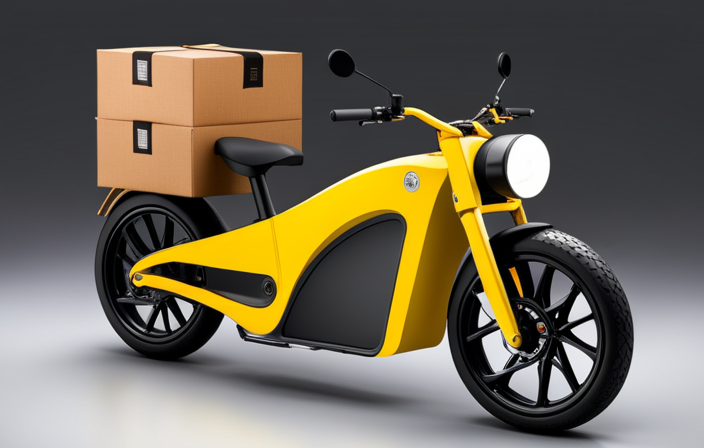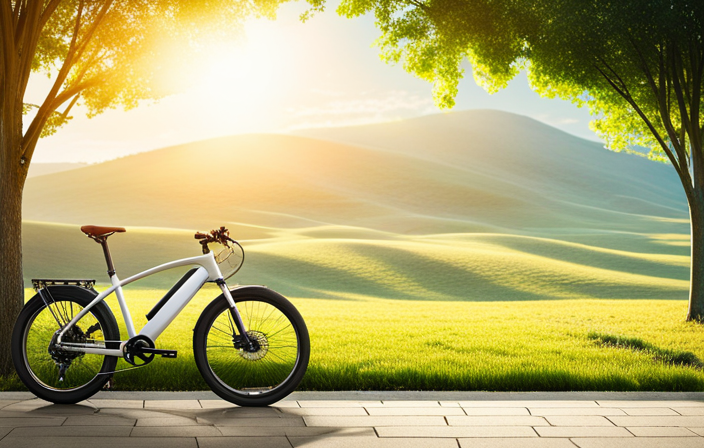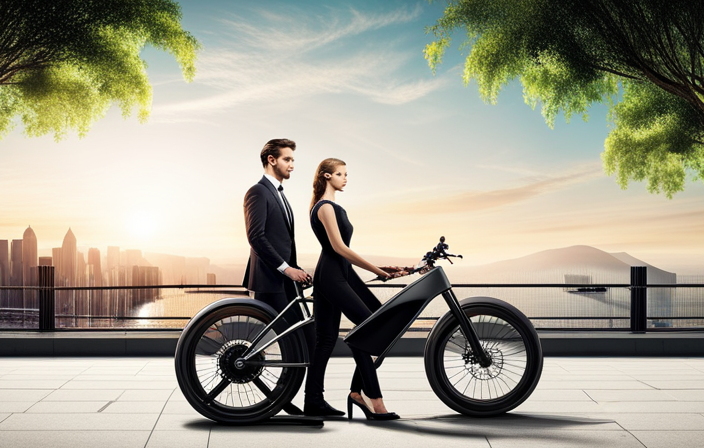Riding an electric bike is an exhilarating experience, but what if you could make it even faster?
In this guide, I will show you how to unleash the full potential of your electric bike and take your speed to new heights.
From upgrading your batteries to replacing the motor, I will share technical tips and insider knowledge to help you achieve maximum velocity.
So, buckle up and get ready to turbocharge your electric bike for an adrenaline-fueled ride like never before.
Key Takeaways
- Apply lubricant regularly for smooth performance and to reduce friction and wear and tear.
- Upgrade the bike’s controller to enhance speed control, improve motor power, and battery efficiency.
- Use a throttle-assist system to boost power and control, relying on battery power for an enhanced biking experience.
- Utilize the pedal assist mode strategically to boost pedaling efforts and adjust assistance levels for different terrains, improving overall riding experience.
Check Your Bike’s Current Speed and Performance
Now, let’s take a moment to see how your electric bike is currently performing and how fast it’s going.
Regular check-ups and maintenance are crucial for keeping your electric bike in top shape and ensuring optimal performance. By conducting routine inspections, you can identify any potential issues or wear and tear early on, preventing major problems down the line.
Regular maintenance not only extends the lifespan of your bike but also improves its efficiency and speed. It allows you to address any issues promptly, such as tire wear, chain lubrication, and brake adjustments.
By keeping your electric bike well-maintained, you can maximize its potential and enjoy a smoother, faster ride.
With that in mind, let’s explore how upgrading your batteries can provide more power for your bike.
Upgrade Your Batteries for More Power
By swapping out your current batteries for high-performance alternatives, you’ll unleash an electrifying surge that will leave you exhilarated and craving for more speed. Upgrading your batteries not only increases your electric bike’s power but also significantly enhances its overall performance.
One way to achieve this is by increasing the battery life. High-performance batteries are designed to provide longer-lasting power, allowing you to ride for extended periods without worrying about running out of juice.
Additionally, upgrading your battery capacity will give your electric bike the extra boost it needs to go faster. With a higher capacity battery, you’ll experience improved acceleration and top speed, making your rides even more thrilling.
Now, let’s explore how replacing the motor can further enhance your electric bike’s speed and performance.
Replace the Motor for Increased Speed
To achieve even greater speed on your electric bicycle, consider replacing the motor with a more advanced model. By doing so, you can experience the benefits of increased power and efficiency, allowing you to effortlessly glide through the streets with unparalleled velocity.
A motor replacement offers several advantages, including improved acceleration and top speed. With a more powerful motor, you can conquer steep inclines and reach higher speeds in a shorter amount of time. Additionally, a new motor can enhance the overall performance and responsiveness of your electric bike, making your rides even more enjoyable.
It is important to note that the cost of a motor replacement can vary depending on the brand and specifications of the new motor. However, the investment is well worth it for those seeking a thrilling and exhilarating electric biking experience. By upgrading your motor, you can take your speed to new heights and enjoy the ride of a lifetime.
Transitioning into the next section, installing a speedometer will allow you to monitor your progress and track your increased speed effortlessly.
Install a Speedometer and Monitor Your Progress
Installing a speedometer allows you to effortlessly track and monitor your progress as you zip through the streets on your electric bicycle. To enhance your cycling experience and optimize your bike’s performance, consider installing a GPS tracker.
This handy device not only tracks your speed and distance, but also provides valuable data that can help you analyze and improve your riding habits. With a speedometer and GPS tracker, you can easily keep track of your average speed, maximum speed, and distance covered during each ride.
This information is crucial for setting goals, measuring your progress, and pushing yourself to go faster. By monitoring your speed and distance, you can identify areas where you can improve and make adjustments to optimize your bike’s aerodynamics, ensuring a smoother and faster ride.
Optimize Your Bike’s Aerodynamics
Enhance your cycling experience and achieve optimal performance on your electric bicycle by optimizing its aerodynamics.
Improving wind resistance is key to increasing your bike’s speed. One way to do this is by experimenting with different bike positions. For example, lowering your body and tucking in your elbows can reduce drag and make you more streamlined.
Another technique is to position your handlebars and seat in a way that minimizes wind resistance. Additionally, consider adding aerodynamic accessories such as a fairing or aero bars. These can help redirect airflow and reduce drag.
By optimizing your bike’s aerodynamics, you can significantly increase your speed and efficiency.
In the next section, we will explore how to further improve performance by reducing weight through removing unnecessary accessories.
Reduce Weight by Removing Unnecessary Accessories
To further optimize your electric bike’s performance and increase its speed, it is crucial to reduce unnecessary weight. By removing any accessories that are not essential for your ride, you can significantly minimize the overall weight of your bike.
This reduction in weight directly translates to improved acceleration and higher top speeds. Maximizing efficiency is key, and one effective way to achieve this is by choosing lightweight materials for your bike’s components. Lightweight materials such as carbon fiber or aluminum can replace heavier alternatives like steel, reducing the overall weight without compromising durability.
By incorporating these lightweight materials, you can enhance your electric bike’s power-to-weight ratio, resulting in faster acceleration and increased speed.
Now, let’s delve into the next section and explore how using a higher gear ratio can further enhance your bike’s acceleration.
Use a Higher Gear Ratio for Faster Acceleration
By utilizing a higher gear ratio, riders can experience a significant boost in their electric bike’s acceleration capabilities. Higher gear ratios for improved acceleration allow the bike to transfer more power from the motor to the wheels, resulting in faster acceleration and a thrilling riding experience.
This is achieved by using a smaller chainring in the front and a larger cassette cog in the rear. By increasing the gear ratio, riders can take full advantage of the available battery power, propelling the bike forward with greater force and achieving higher speeds.
However, it’s important to note that using a higher gear ratio may require more effort from the rider, especially when climbing hills or riding against strong headwinds. Therefore, it’s essential to find the right balance between acceleration and ease of pedaling.
To further enhance your electric bike’s performance, the next step is to inflate your tires to the recommended pressure.
Inflate Your Tires to the Recommended Pressure
Inflate your tires to the recommended pressure for a smoother and more efficient ride. Increasing the tire pressure can improve the speed and performance of your electric bike. Here are three reasons why you should pay attention to tire pressure:
-
Increased Efficiency: Properly inflated tires reduce rolling resistance, allowing you to go faster with less effort.
-
Improved Handling: Higher tire pressure provides better stability and control, especially when taking corners or navigating uneven terrain.
-
Extended Battery Life: With optimal tire pressure, your electric bike requires less power to propel forward, resulting in longer battery life.
To ensure accurate measurement of tire pressure, consider installing a speedometer on your electric bike. This device not only displays your current speed but also helps you maintain the ideal pressure for maximum performance.
Remember, maintaining your bike’s chain and gears is crucial for smooth performance, so let’s delve into that next.
Maintain Your Bike’s Chain and Gears for Smooth Performance
Maintaining your bike’s chain and gears ensures a smooth and effortless ride, enhancing your overall biking experience. Proper lubrication is essential for smooth chain and gear performance. Regularly applying lubricant to your chain reduces friction, prevents wear and tear, and improves power transmission. Make sure to choose a lubricant specifically designed for bike chains, and apply it evenly along the entire length of the chain.
Additionally, regular cleaning is crucial for optimal chain and gear function. Use a degreaser and a brush to remove dirt, grime, and old lubricant from the chain and gears. This will help prevent rust, improve shifting, and extend the lifespan of your components.
By properly maintaining your bike’s chain and gears, you can maximize performance and prolong the life of your electric bike.
This leads us to the next section, where we will discuss how to upgrade your bike’s controller for better speed control.
Upgrade Your Bike’s Controller for Better Speed Control
Enhance your riding experience by upgrading your bike’s controller, allowing for smoother and more precise speed control. Upgrading the controller is an effective way to upgrade motor power and improve battery efficiency. By increasing the motor power, you can achieve higher speeds and better acceleration. Additionally, a more efficient controller can optimize battery usage, extending your bike’s range and reducing the need for frequent recharging.
Consider the following table which compares the features of different controllers:
| Controller | Motor Power Control | Battery Efficiency |
|---|---|---|
| Standard | Basic speed control | Average |
| Upgraded | Precise speed control | High |
| Advanced | Advanced speed control | Excellent |
Upgrading your bike’s controller provides you with better speed control while also improving motor power and battery efficiency. Consider using a throttle-assist system for an even more customizable riding experience.
Consider Using a Throttle-Assist System
Consider using a throttle-assist system to amplify your biking experience and add an extra touch of exhilaration without resorting to the overused notion of speed.
Throttle assist systems are a popular choice among electric bike enthusiasts, providing a boost in power and control. With these systems, you can easily regulate your speed by simply twisting the throttle.
There are different types of throttle-assist systems available, including thumb throttles and twist throttles, each with its own set of advantages and disadvantages. Thumb throttles offer precise control and are ideal for off-road adventures, while twist throttles provide a more natural grip and are suitable for longer rides.
However, it’s important to note that throttle-assist systems rely on battery power, which may limit your overall range.
By incorporating a throttle-assist system, you can enhance your biking experience and seamlessly transition into the subsequent section about using pedal assist mode effectively.
Use Pedal Assist Mode Effectively
To truly optimize your biking experience, you’ll want to tap into the full potential of pedal assist mode and harness the power of your own physical strength. Pedal assist mode is a feature commonly found in electric bikes that provides a boost to your pedaling efforts. By using this mode effectively, you can improve efficiency and maintain battery life.
Here are three ways to make the most of pedal assist mode:
-
Find the right level: Experiment with different levels of assistance to find the one that suits your riding style and terrain. Using a higher level of assistance when climbing hills or facing strong headwinds can help conserve your energy.
-
Use pedal assist strategically: Instead of relying solely on the motor, try to maintain a steady cadence and use the pedal assist as a supplement. This way, you can maximize the efficiency of your pedaling and extend your battery life.
-
Learn to anticipate: Anticipate changes in terrain or road conditions and adjust your pedal assist accordingly. For example, you can increase the assistance level when approaching a steep incline and decrease it when going downhill to maintain control and improve battery efficiency.
By mastering these techniques, you can improve your overall riding experience and ensure that you’re getting the most out of your electric bike.
Now, let’s explore how to adjust your riding technique to maximize speed.
Adjust Your Riding Technique to Maximize Speed
As you fly down the open road, imagine the wind whipping through your hair as you effortlessly glide along, using the perfect combination of balance, technique, and speed to make the most of your electric bike.
To maximize efficiency and achieve higher speeds, it is crucial to adjust your riding technique. Proper body positioning plays a vital role in this process. By maintaining an aerodynamic posture, you reduce wind resistance and improve your overall speed. Keep your back straight, elbows slightly bent, and head up, allowing for better control and balance. Additionally, shifting your weight slightly forward while pedaling can optimize power transfer to the wheels. These adjustments, when combined with the pedal assist mode, can significantly enhance your electric bike’s speed and performance.
Transitioning into the subsequent section about ‘practice regular maintenance and tune-ups,’ it is essential to maintain your bike’s components for optimal performance.
Practice Regular Maintenance and Tune-Ups
Don’t neglect your electric steed, for regular maintenance and tune-ups are the key to keeping your ride in top-notch shape, ensuring it purrs like a well-oiled machine. To improve acceleration and increase top speed, here are some essential maintenance tips:
- Keep your tires properly inflated to reduce rolling resistance.
- Lubricate the chain regularly to minimize friction and maximize power transfer.
- Clean the bike regularly to remove dirt and debris that can slow you down.
- Check and adjust the brakes to ensure optimal stopping power.
- Inspect the battery and electrical connections to ensure a consistent power supply.
By practicing these maintenance tasks, you can optimize the performance of your electric bike and enjoy a faster ride. However, it’s important to always ride responsibly and observe traffic laws to ensure your safety and the safety of others on the road.
Now, let’s move on to the next section about riding responsibly.
Always Ride Responsibly and Observe Traffic Laws
When you hop on your electric steed, always remember to ride responsibly and follow traffic laws, ensuring a smooth and safe journey for both you and others on the road.
Riding an electric bike can be an exhilarating experience, but it’s important to prioritize safety. To ride safely, it is crucial to follow traffic rules such as stopping at red lights, yielding to pedestrians, and using hand signals to indicate your intentions.
Additionally, maintaining awareness of your surroundings is paramount. Keep a keen eye on other vehicles, pedestrians, and potential hazards to anticipate and avoid any potential accidents.
By adhering to traffic laws and staying alert, you can enjoy a faster electric bike ride while minimizing the risks associated with reckless behavior.
Frequently Asked Questions
Can I increase the speed of my electric bike by adjusting my riding technique?
No, adjusting your riding technique alone will not increase the speed of your electric bike. The speed is primarily determined by the power output of the battery, which can be improved by upgrading to a higher capacity battery.
Are there any legal restrictions on how fast an electric bike can go?
There are legal restrictions on the maximum speed an electric bike can go, which vary by country. These restrictions are in place to ensure safety and prevent accidents caused by excessive speed.
How often should I perform maintenance and tune-ups on my electric bike to ensure optimal speed?
I recommend following a maintenance schedule to ensure optimal speed on your electric bike. Regular tune-ups, including checking tire pressure, lubricating the chain, and inspecting the brakes, can help improve speed and performance.
Can I use a throttle-assist system to make my electric bike go faster?
Yes, using a throttle-assist system can increase the speed of an electric bike. However, it’s important to consider the impact of weight on electric bike speed as modifications may affect performance.
What are the advantages of using pedal assist mode for increasing speed on an electric bike?
The advantages of using pedal assist mode on an electric bike include increased speed, improved efficiency, and extended battery life. To maximize pedal assist efficiency, maintain a consistent cadence, shift gears appropriately, and adjust the assist level according to terrain and desired effort.
Conclusion
Well, there you have it, folks! We’ve reached the end of our electrifying journey on how to make your electric bike go faster.
From upgrading your batteries to replacing the motor, we’ve covered it all.
With a speedometer to track your progress and some aerodynamic adjustments, you’ll be zooming through the streets in no time.
Just remember to use pedal assist mode effectively and adjust your riding technique for maximum speed.
And of course, don’t forget to practice regular maintenance and follow those pesky traffic laws.
Happy riding, speed demons!









